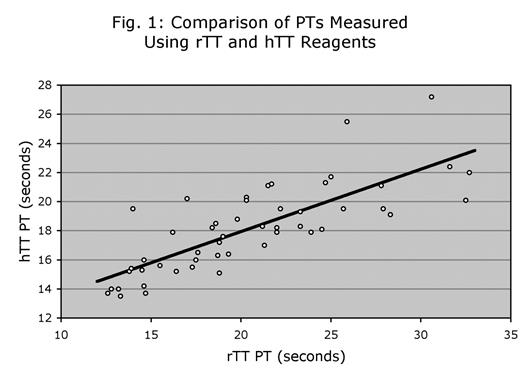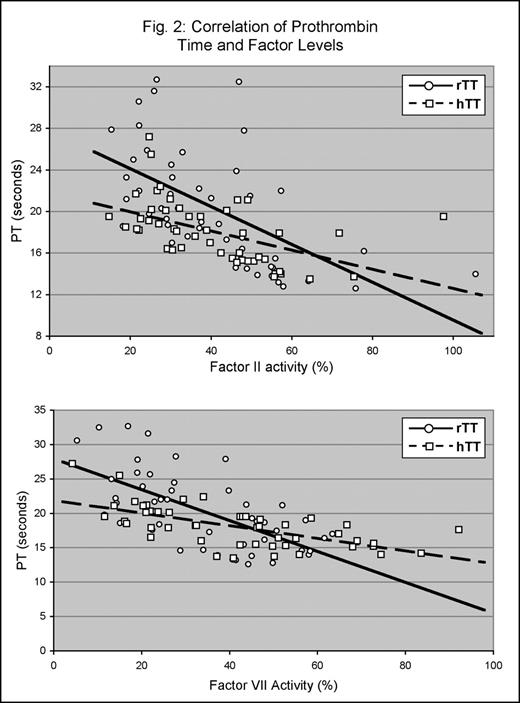Abstract
Acquired coagulopathies are often treated with fresh frozen plasma (FFP) transfusion. Standards for the tranfusion of FFP vary, but are often based on coagulation tests, especially prothrombin time (PT). Previously, the PT test was performed using tissue thromboplastin (TT) reagents derived from human or animal tissue homogenates (hTT). These preparations were fairly crude and varied between manufacturers and lots. Recently, these have been replaced with recombinant TT (rTT) reagents that are more consistent. However, anecdotal reports suggest that rTT is more sensitive to mildly decreased clotting factor levels, leading to longer PTs and increases in FFP transfusion. The purpose of this study is to test the hypothesis that rTT reagents are more sensitive and to determine if thresholds for FFP transfusion should be increased. Fifty plasma samples from patients with prolonged PTs (range 13.0–27.6 seconds; normal 9.2–12.8 seconds) were randomly selected. PTs for each sample were re-measured using rTT (Innovin, Dade-Behring, Liederbach, Germany; ISI=0.91) and hTT (Thromboplastin Reagent, Helena Laboratories, Beaumont, Texas; ISI=2.07) on the same instrument (Start 4 benchtop coagulation analyzer, Diagnostica Stago, Parsippany, New Jersey). These measured PTs are compared in Fig. 1. At the lower end of the PT range (beginning at ~13 seconds), the rTT PTs are shorter, on average, than the hTT PTs. However, the average rTT PT increases at a 1.4 times greater rate than the hTT PT, such that the average PT of the two reagents is equivalent at 16.4 seconds and longer for rTT thereafter. This suggests that the rTT reagent is indeed more sensitive. A similar pattern is seen when factor II and VII levels for each sample are plotted against the corresponding PT (Fig. 2). At high factor levels, the rTT PT is lower, on average, than the hTT PT. However, as factor levels decrease, the rTT PT rises about twice as fast as the hTT PT. The PTs for the two reagents are equivalent at 66% factor II (PT=15.7) and 46% factor VII (PT=17.7). The important thresholds for risk of surgical bleeding are 40% factor II and 25% factor VII. The equivalent PTs in this study are 20.5 (rTT) and 18.1 (hTT) for 40% factor II and 22.3 (rTT) and 19.6 (hTT) for 25% factor VII. These differences are not corrected by converting PTs to the international normalized ratio (INR). Instead, INRs are higher for hTT than rTT, and the degree of difference between the two reagents is greater. The equivalent INRs are 1.90 (rTT) and 2.54 (hTT) for 40% factor II activity, and 2.05 (rTT) and 2.98 (hTT) for 25% factor VII activity. The results of this study confirm that PTs measured using rTT are more sensitive to changes in clotting factor levels than those measured using hTT, especially at clinically significant factor levels. This suggests that thresholds for the transfusion of FFP should be raised at those institutions using rTT.
Author notes
Corresponding author



This feature is available to Subscribers Only
Sign In or Create an Account Close Modal